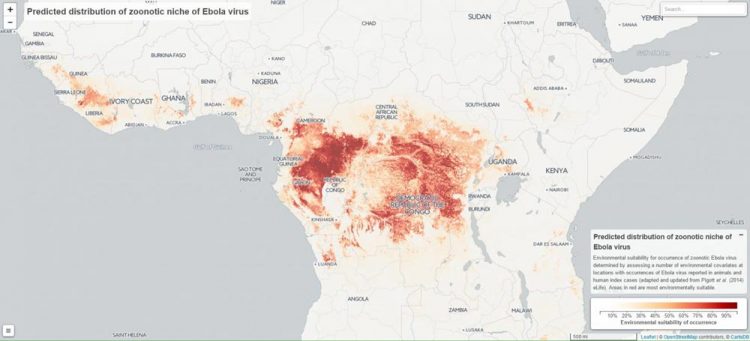Over 20 countries environmentally suitable for Ebola transmission by bats

Updates to the zoonotic niche map of Ebola virus disease in Africa by David Pigott et al. are published in eLife Credit: IHME
Though the West African Ebola outbreak that began in 2013 is now under control, 23 countries remain environmentally suitable for animal-to-human transmission of the Ebola virus. Only seven of these countries have experienced cases of Ebola, leaving the remaining 16 countries potentially unaware of regions of suitability, and therefore underprepared for future outbreaks.
These findings come from a new study published today in the journal eLife titled “Updates to the zoonotic niche map of Ebola virus disease.” The paper was led by researchers from the Institute for Health Metrics and Evaluation (IHME) at the University of Washington in Seattle.
Only a handful of countries saw cases of Ebola before 2013, until Guinea unexpectedly reported an outbreak that led to more than 28,000 cases and 11,000 deaths across West Africa. The current eLife study provides an update on a study published in 2014 that created a zoonotic niche map used to define areas of environmental suitability for Ebola in response to the outbreak.
This map identified regions where the virus could be transmitted from animals to humans. The updated map published today incorporates more species of bats likely capable of transmitting Ebola, as well as new reports of the virus.
Alongside the current study and update, IHME launched a new, online data visualization tool, available to stakeholders and the public.
“The visualization tool provides an important way for various end users to engage and interrogate these updated maps,” explains the paper's lead author Dr. David Pigott, an Assistant Professor at IHME. “Unlike with the previous publication, anyone can now directly interact with the maps, use the tool, and better assess the potential threat that Ebola virus disease poses to their regions of interest.”
The tool allows users to view previous Ebola index cases, as well as explore the areas where bat species thought to be capable of transmitting the virus are predicted to live. The maps are displayed in a 5-by-5 km grid across Africa, allowing users to zoom into their countries to see areas of interest. This type of geospatial mapping tool is the first of its kind from IHME.
In countries where an Ebola outbreak is possible, the update and new data visualization are powerful tools that allow decision-makers to set policies to prepare for potential outbreaks in the future.
###
Read the full-report: http://dx.
Explore the data visualization tool: http://vizhub.
Learn about the Ebola workshop in Acting on Data: http://www.
Media Contacts:
Kayla Albrecht, MPH, +1-206-897-3792 (office); +1-203-335-2669 (cell); albrek7@uw.edu
Established in 2007, The Institute for Health Metrics and Evaluation (IHME) is an independent global health research center at the University of Washington in Seattle that provides rigorous and comparable measurement of the world's most important health problems and evaluates strategies to address them. IHME makes this information available so that policymakers, donors, practitioners, researchers, and local and global decision-makers have the evidence they need to make informed decisions about how to allocate resources to best improve population health. For more information, visit: http://www.
Full list of funders:
Vulcan (Vulcan Incorporated): David M Pigott, Anoushka I Millear, Lucas Earl, Chloe Morozoff, Simon I Hay, 11878; HHS | NIH | National Institute of General Medical Sciences (NIGMS): Barbara A Han, U01GM110744; Rhodes Scholarships: Freya M Shearer; Bill and Melinda Gates Foundation (Bill & Melinda Gates Foundation): Oliver J Brady, OPP1119467; DAAD | German Academic Exchange Service London (DAAD London): Moritz UG Kraemer, Graduate Scholarship; Bill and Melinda Gates Foundation (Bill & Melinda Gates Foundation): Catherine L Moyes, Nick Golding, OPP1053338; Bill and Melinda Gates Foundation (Bill & Melinda Gates Foundation): Daniel J Weiss, Samir Bhatt, Peter W Gething, OPP1068048, OPP1106023; Medical Research Council (MRC): Peter W Gething, MRC/DFID Concordat agreement; Department for International Development (DFID): Peter W Gething, MRC/DFID Concordat agreement; Wellcome T rust: Simon I Hay, Senior Research Fellowship (095066); Bill and Melinda Gates Foundation (Bill & Melinda Gates Foundation): Simon I Hay, OPP1093011, OPP1132415; DHS | Science and Technology Directorate (S&T ): David M Pigott, Barbara A Han, RAPIDD program The funders had no role in study design, data collection and interpretation, or the decision to submit the work for publication.
Media Contact
All latest news from the category: Health and Medicine
This subject area encompasses research and studies in the field of human medicine.
Among the wide-ranging list of topics covered here are anesthesiology, anatomy, surgery, human genetics, hygiene and environmental medicine, internal medicine, neurology, pharmacology, physiology, urology and dental medicine.
Newest articles

Bringing bio-inspired robots to life
Nebraska researcher Eric Markvicka gets NSF CAREER Award to pursue manufacture of novel materials for soft robotics and stretchable electronics. Engineers are increasingly eager to develop robots that mimic the…

Bella moths use poison to attract mates
Scientists are closer to finding out how. Pyrrolizidine alkaloids are as bitter and toxic as they are hard to pronounce. They’re produced by several different types of plants and are…

AI tool creates ‘synthetic’ images of cells
…for enhanced microscopy analysis. Observing individual cells through microscopes can reveal a range of important cell biological phenomena that frequently play a role in human diseases, but the process of…





















